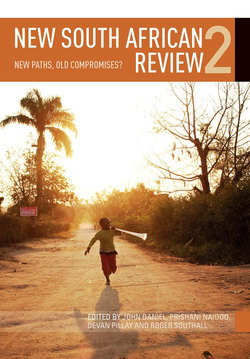Читать книгу New South African Review 2 - Paul Hoffman - Страница 22
На сайте Литреса книга снята с продажи.
CONTINUED, BUT DECLINING, SUPPORT FOR THE ALLIANCE
ОглавлениеCosatu’s support for the ANC during the 2011 municipal elections (even while it continued to criticise government policy) underlined its commitment to building the ANC Alliance. It continues to believe in the strategy of ‘swelling the ranks’ of the ANC to ensure that in future it elects leaders who truly have the interests of the working class at heart.
A survey15 of Cosatu members’ political attitudes confirmed the continued, if gradually declining, popularity of the ANC and the alliance among workers. Support still remains at sixty per cent (down from eighty-two per cent in 1994, seventy per cent in 1998 and sixty-six per cent in 2004). However, those who are now unhappy about the alliance are more interested in Cosatu being nonaligned (twenty-one per cent), than being part of a new workers’ party (nineteen per cent). Most members clearly have no appetite for breaking away from the party of Mandela, despite their unhappiness with aspects of the ANC’s policies and performance (particularly those concerning access to nutritional food (fifty-five per cent), higher wages (seventy-two per cent), land (fifty-nine per cent), and jobs (seventy-two per cent)).
Interestingly, despite Cosatu’s denunciation of the neoliberal macroeconomic framework Gear, most workers (seventy-five per cent) had never heard of it. Of those that had, only forty per cent believed it was achieving its goals of growth, employment and redistribution. However, only forty-five per cent believed that it was not. Tellingly, sixty-two per cent of the workers vote for the ANC because of its policies or past performance, while only twenty-one per cent vote out of loyalty or because the union told them to (two per cent). It is clear that, despite anger at government for not meeting many working-class aspirations, for most workers this does not yet mean abandoning the ANC or the alliance. If the ANC does not satisfy workers in future, only six per cent of them are interested in forming an alternative workers’ party (compared to thirty-eight per cent in 2004, and thirty-three per cent in 1998). Workers prefer ongoing mass action or pressurising unionists in parliament (sixty-two per cent). In other words, worker sentiments are not out of line with those of the union leadership. Working-class aspirations, for most Cosatu members, must be fought for within the ANC and the alliance, rather than outside it – and the post-Polokwane ANC appears more attentive to the working class. Nevertheless, while worker support for the ANC during the May 2011 municipal elections was largely uncontested outside the Western Cape, Cosatu’s Vavi revealed that he had to campaign vigorously in Port Elizabeth to ensure that workers came out to vote ANC.16
Is this the case of relative ‘insiders’ (organised workers) being comfortable with a liberation movement that has brought them some benefits such as better housing (fifty-six per cent), access to clean water (eighty-one per cent), electricity (seventy-nine per cent), a telephone (sixty-five per cent), better public transport (fifty-five per cent), better healthcare (fifty-three per cent), HIV/AIDS treatment (sixty-two per cent), education and training (sixty-two per cent) and a clean and healthy working and living environment (sixty-one per cent)? While the majority seems relatively satisfied, a sizeable minority is not. The unemployed and underemployed majority are likely to be much less satisfied, as rising ‘service delivery’ protests indicate.
Nevertheless, the ANC vote increased from 10.9 million in 2004 to 11.7 million in 2009 (less than the 12.2 million votes cast in 1994, but significant nonetheless) (Southall and Daniel, 2009). While much of this support came from organised workers, it is safe to assume that the 11.7 million also included a large number of unorganised workers and the unemployed in urban and rural areas.
However, while voter support generally correlated with increased satisfaction regarding ‘national economic’ and ‘overall conditions’ (Schulz-Herzenberg, 2009: 33), 6.8 million of the 30 million entitled to vote in 2009 did not register, while a further 5.3 million who did register did not vote, making a total of 12.1 million voters (40.3 per cent of eligible voters) who did not vote. This indicates significant alienation from the political process among a large section of the population who see little return from voting, particularly within the context of rising ‘service delivery’ protests. Indeed, while the percentage of valid votes for the ANC remained stable at sixty-six per cent, the percentage of eligible voters voting for the ANC declined from 53.8 per cent in 1994 to 38.8 per cent in 2009 (Schulz-Herzenberg, 2009).
While the ANC received sixty-two per cent of all votes cast in the 2011 municipal elections, according to Hassen (2011b), using Statistics South Africa’s 2010 Mid-Year Population Estimates, 15.6 million eligible voters over the age of twenty did not vote, compared to the 13.7 million voters who did. If eighteen- to twenty-year-olds are included, the ‘silent majority’ increases, indicating a significant and potentially increasing degree of voter alienation (taking into account that municipal elections normally attract lower voter turnouts).
Does this mixed picture nevertheless give hope to those seeking to build an alternative pole of attraction to that of the ANC?
